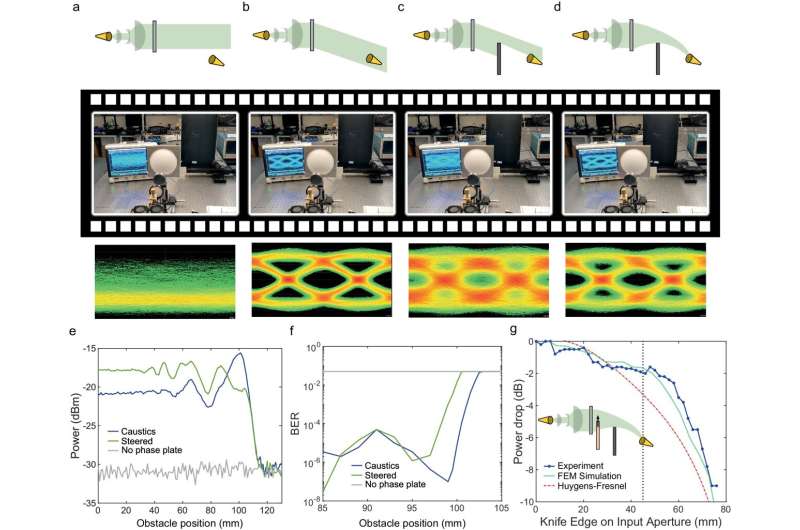This article has been reviewed according to Science X's editorial process and policies. Editors have highlighted the following attributes while ensuring the content's credibility:
fact-checked
trusted source
proofread
First curved data link side-steps key 6G wireless challenge

Next-generation wireless signals will no longer emanate indiscriminately from a base station as is the case now but will likely take the form of targeted directional beams. However, any physical interference—an object or a person passing nearby, for example—could interrupt the signal, posing a literal obstacle toward the implementation of ultrafast millimeter-wave and sub-terahertz wireless networks.
Researchers at Rice University and Brown University, however, have shown that data-laden curved beams can establish a link between base stations and users, effectively side-stepping intervening obstacles.
In a study published in Communications Engineering, the researchers demonstrated a sub-terahertz beam that follows a curved trajectory ⎯ an achievement that could revolutionize wireless communications by making a future of wireless data networks running on sub-terahertz frequencies more feasible.
"This is the world's first curved wireless data link, a critical milestone in realizing the 6G vision of high data rate and high reliability," said Edward Knightly, the Sheafor-Lindsay Professor of Electrical and Computer Engineering and professor of computer science at Rice.
"Whereas today's lower frequency Wi-Fi seemingly propagates in all directions like a radio broadcast, in the future for faster data rates at higher frequencies, beams have to be directional to propagate."
Cellular networks and Wi-Fi systems today rely on lower frequency gigahertz radiation to carry data, but future technology will rely on sub-terahertz waves, which have as much as 100 times the data-carrying capacity.
"We want more data per second," said Daniel Mittleman, a professor in Brown's School of Engineering and senior author of the study. "If you want to do that, you need more bandwidth, and that bandwidth simply doesn't exist using conventional frequency bands."
The researchers explored self-accelerating beams ⎯ specially configured electromagnetic waves that curve as they move through space ⎯ as a starting point for their work. By engineering transmitters that control the strength and frequency of emitted waves in a coordinated fashion, the researchers were able to ensure that data gets transferred along a curved parabolic trajectory.
"Curving a beam doesn't solve all possible blockage problems, but what it does is solve some of them and it solves them in a way that's better than what others have tried," said Hichem Guerboukha, who led the study as a postdoctoral researcher at Brown and is now an assistant professor at the University of Missouri-Kansas City.
The researchers validated their findings through extensive simulations and experiments navigating around obstacles to maintain communication links with high reliability and integrity.
By using these curved beams, the researchers say they hope to enable new applications such as mobile immersive augmented reality. Such applications require a high data rate that must be sustained despite the mobility of the user and nearby obstacles.
More information: Hichem Guerboukha et al, Curving THz wireless data links around obstacles, Communications Engineering (2024). DOI: 10.1038/s44172-024-00206-3
Provided by Rice University




















